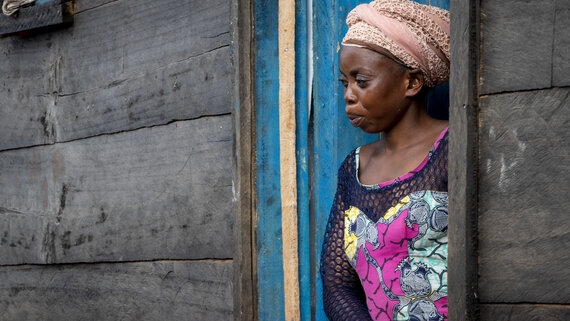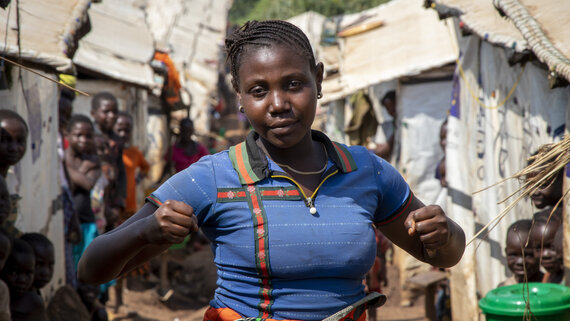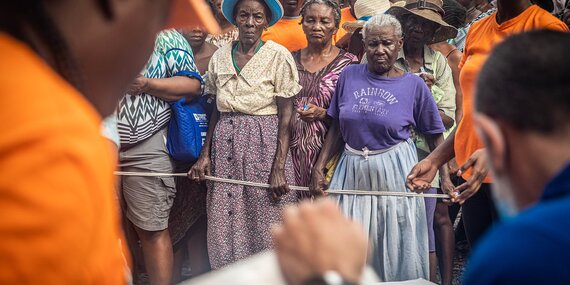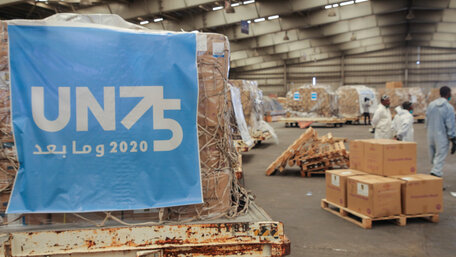Les Cayes, Haiti
A group of older women wait to collect aid supplies following the earthquake that hit Haiti in August. One of the women is now homeless. Like many others, she sleeps in a tent erected at an assembly point next to a school outside Les Cayes. But finding food is a major concern. She explains: "Since this morning, I haven't even had so much as a coffee. Sometimes we all put together what we have so we can prepare a meal. But it's never enough for everyone. Some people eat, others don't. As a result, we are hungry, and children ask for food we cannot give them.” OCHA/Matteo Minasi
Gender inequalities continued to worsen in 2020. Women and girls were disproportionately affected by the pandemic and other global crises, exacerbating pre-existing gender norms and inequalities.
The COVID-19 pandemic is dealing a major blow to women’s employment progress and ending poverty. Women represent 70 per cent of the global health and social sector force, and they are at the front lines of the pandemic. Despite this, 4.2 per cent of all employed women lost their jobs in 2020, compared to 3 per cent employment losses for men. Poverty rates for women and girls also continued to worsen; about 247 million women over age 15 live on less than $1.90 per day, compared to 236 million men. The global gender poverty gap for women age 25 to 34 is projected to worsen, from 118 women for every 100 men in 2021, to 121 women in 2030.
Female employment (2015-2021)
Despite some progress over the past decade, gender parity remains far from reach as women and girls continue to face structural marginalization and discrimination. According to the World Economic Forum, the fallout from the COVID-19 pandemic could add another generation to the fight for gender parity, a goal predicted to take over 100 years to achieve.
Women and girls living in humanitarian contexts continue to be among those most affected by gender inequalities, such as limited access to decision-making processes, education, work, and gaps in sexual and reproductive health services.
Countries with a HRP in 2020 had some of the widest gender gaps. This makes it even more important to ensure humanitarian action promotes the protection, participation and leadership of women and girls, particularly adolescent girls, older women, and women and girls with disabilities.
Gender Inequality Index (2020)
Violence against women and girls has intensified in some settings, giving rise to a shadow pandemic of GBV. COVID-19 and economic slowdowns have also adversely impacted services and programmes for GBV. For every three months that COVID-19 lockdowns continue, an additional 15 million GBV cases are expected to occur. Women and girls living in humanitarian contexts are experiencing GBV at a disproportionate rate.
Women and girls are also disproportionately impacted by climate shocks. Those living in rural areas are more dependent on natural resources for their livelihoods, which are threatened by a changing climate. Such vulnerabilities can intensify the risk of GBV, which may become more acute following climate-related disasters. Women and girls are often severely limited by gendered systems, structures, laws and social expectations, and underrepresented in decision-making processes on climate action.

Mangina, DR Congo
Maria has been at Kamuchanga IDP site for three months. Her village was attacked, and she was kidnapped by armed men, but her husband was killed. After two months, she managed to escape during a clash with military forces. She found her younger brother and is staying with him and her daughter. But Maria’s leg is badly infected. She explains: “They injured my leg, stabbing me with bayonets. The injury is now five months old, but it does not heal. I had to leave the hospital because I could not pay for the treatment. When I have enough money for antibiotics, it gets better. But when I have to stop again, because I run out of money, the infection gets worse again. I can walk very slowly but cannot work. People in the community are the only ones who help me. My neighbours share food with me. I am surviving through the charity of others.”
OCHA/Ivo BrandauAddressing the acute needs of women and girls will require greater investment in humanitarian programming, informed by women’s meaningful participation, especially through community-/women-led organizations and local partners, to shape the humanitarian response as well as their equal representation in humanitarian leadership positions. Robust gender analysis and the use of sex- and age-disaggregated data, including ethnicity, race, migratory status and disability, are critical to close gender gaps.
Such efforts must be coupled with policies that expand the access of women, girls and other at-risk groups to social protection, dignified sustainable livelihoods and economic opportunities, and affordable, quality and accessible health-care services. Humanitarian response services must be gender-transformative and centred around building resilience to future shocks. And specifically, humanitarian response must prioritize the prevention of, response to and risk mitigation of GBV to ensure that humanitarian operations do not increase the risk of experiencing GBV, including sexual exploitation and abuse.
Supporting and counselling for displaced women

Tumahini Mave is the Protection Committee President at Linji IDP site in DRC. When her village was attacked, she followed the village chief to find refuge at the site. It hosts several thousand IDPs and is located near small gold mines, where many IDPs go to find a day’s labour or dig for a lucky find. The fields and paths around the site expose all IDPs to great risks, particularly women and girls. Protection incidents often go unreported.
Tumahini is a mother of four and struggling to make ends meet for her family. She puts all her energy into supporting and counselling other displaced women. She explains: “I fled the fighting in my village. I heard the shots, people were hit. They burned down the village. I took my children and ran. Here it is dangerous. I am counselling women at any time, whatever happens. When they leave the site to look for wood or food, they are being harassed and forced to have sex for food. When women are raped, they prefer to keep silent. They risk being discriminated and rejected by their husbands. I am surviving with little activities, helping out in the fields of the local population, carrying building materials or in the gold mine. Because of the risks, I try to leave the site as little as possible.”
Across the humanitarian sector, there has been a growing focus on increasing the meaningful participation of women and women-led organizations in humanitarian action. In 2020, gender working groups were active in 12 crisis settings: Cameroon, CAR, Chad, Jordan, Myanmar, Nigeria, occupied Palestinian territory, Philippines, Somalia, Syria, Ukraine and Yemen. Regional gender in humanitarian action working groups covered the Middle East and North Africa and Asia-Pacific. Local women-led organizations have increasingly engaged in meaningful participation in the HPC design and planning and HCTs, particularly in Ethiopia, Iraq, Myanmar, Syria and Yemen.
Further reading
Source: UN Women
Source: World Economic Forum
Source: UNFPA
References
- UNFPA, COVID-19: A Gender Lens: Protecting Sexual and Reproductive Health and Rights and Promoting Gender Equality.
- OCHA calculations based on ILO data explorer - Female employment dropped from 1.28 billion to 1.23 billion in 2020.
- UN Women, From Insight to Action, Gender Equality in the Wake of COVID-19.
- World Economic Forum, Global Gender Report 2021.
- According to data from the World Economic Forum’s Global Gender Gap Index 2021 Rankings.
- UN Women and UNFPA, Impact of COVID-19 on Gender Equality and Women’s Empowerment in East and Southern Africa.
- Ibid.
- UNFPA, Impact of the COVID-19 Pandemic on Family Planning and Ending Gender-based Violence, Female Genital Mutilation and Child Marriage.
- ActionAid, On the Frontline: Catalyzing Women’s Leadership in Humanitarian Action.
- World Bank, Poverty and Shared Prosperity 2020: Reversals of Fortune.
- UN Women, Women, Gender Equality, and Climate Change.
- OHCHR, Frequently Asked Questions on Human Rights and Climate Change.
- IFRC, World Disasters Report 2020: Come Heat or High Water, Tackling the Humanitarian Impacts of the Climate Crisis Together.
- UNHCR, Global Report 2020





